Filter by
You must be a CTBUH Member to view this resource.

KK100
KK100 Development, Kingkey 100, Kingkey Finance Center Plaza, Kingkey Finance Tower
Building
Completed
2011
Hotel / Office
Concrete-Steel Composite
LEED Gold
441.8 m / 1,449 ft
98
4
249
2000
66
9 m/s
220,000 m² / 2,368,060 ft²
You must be a CTBUH Member to view this resource.
You must be a CTBUH Member to view this resource.
Proposed
Construction Start
Completed
Usually involved in the front end design, with a "typical" condition being that of a leadership role through either Schematic Design or Design Development, and then a monitoring role through the CD and CA phases.
The Design Engineer is usually involved in the front end design, typically taking the leadership role in the Schematic Design and Design Development, and then a monitoring role through the CD and CA phases.
The Design Engineer is usually involved in the front end design, typically taking the leadership role in the Schematic Design and Design Development, and then a monitoring role through the CD and CA phases.
The main contractor is the supervisory contractor of all construction work on a project, management of sub-contractors and vendors, etc. May be referred to as "Construction Manager," however, for consistency CTBUH uses the term "Main Contractor" exclusively.
Material Supplier refers to organizations which supplied significant systems/materials for a building project (e.g. elevator suppliers, facade suppliers, etc).
You must be a CTBUH Member to view this resource.
Usually involved in the front end design, with a "typical" condition being that of a leadership role through either Schematic Design or Design Development, and then a monitoring role through the CD and CA phases.
Usually takes on the balance of the architectural effort not executed by the "Design Architect," typically responsible for the construction documents, conforming to local codes, etc. May often be referred to as "Executive," "Associate," or "Local" Architect, however, for consistency CTBUH uses the term "Architect of Record" exclusively.
The Design Engineer is usually involved in the front end design, typically taking the leadership role in the Schematic Design and Design Development, and then a monitoring role through the CD and CA phases.
The Design Engineer is usually involved in the front end design, typically taking the leadership role in the Schematic Design and Design Development, and then a monitoring role through the CD and CA phases.
The main contractor is the supervisory contractor of all construction work on a project, management of sub-contractors and vendors, etc. May be referred to as "Construction Manager," however, for consistency CTBUH uses the term "Main Contractor" exclusively.
Other Consultant refers to other organizations which provided significant consultation services for a building project (e.g. wind consultants, environmental consultants, fire and life safety consultants, etc).
Material Supplier refers to organizations which supplied significant systems/materials for a building project (e.g. elevator suppliers, facade suppliers, etc).
2012 CTBUH Awards
13 October 2016 - CTBUH Research
21 September 2014 - Event
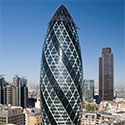
19 October 2016 | Shenzhen
One of the keys to attracting buyers and tenants for a contemporary tall building is a succinct marketing strategy and a robust understanding of how...

31 January 2019
CTBUH Research
In 2018, 143 buildings of 200 meters’ height or greater were completed. This is a slight decrease from 2017’s record-breaking total of 147, and it...
The KK100 development lies between the border of Shenzhen’s business and residential districts in a densely developed area. To facilitate more sustainable development for the fast-growing city, the mixed-use tower was designed to be a hub for transit, provide amenities to the area, and provide an occupant density that would help to reduce urban sprawl and reliance on transportation.
As part of a greater master plan, the site was arranged to include a podium with retail and connections to public transportation, with the tower placed at the southwest end of the site to draw on the views of the city and neighboring Lizhi Park. The site formerly held a residential quarter with poor living conditions. To mitigate the effects of the development on the former residents, a joint initiative was formed which made them stakeholders in the new buildings and maintained the existing community.
The large podium was designed with a response to the site’s foot traffic and context, providing entrances appropriate to the scale and density of the area. A future residential complex will connect to this podium, as well as the tower, to create an integrated development to serve all the needs of its occupants. The main entrance to the tower takes the building skin and pulls it into an inviting curvilinear canopy, funneling in residents and workers.
The tower’s curving form was intended to allude to a fountain of water, symbolizing the wealth and prosperity of the city of Shenzhen. The base of the tower connects to the lower-level programs as well as to the urban fabric at the pedestrian scale. The curved north and south façades are oriented to Hong Kong and the Maipo marshes, while the slender east and west façades taper to the curved apex of the tower, providing less area for morning and evening solar gain.
Levels 4–72 of the building comprise office space, with slightly different floor plates between adjacent levels due to the curve of the tower. The floor-to-floor height is a generous four meters, allowing a maximum of daylight penetration into the work spaces. The layout of the office spaces was generated to provide a great deal of flexibility to meet the needs of various tenants.
Levels 75–95 house the St. Regis Hotel and its own conference and meeting facilities. Hotel visitors arrive at the sky garden lobby on the 94th floor, which opens into a large, open atrium and garden at the top of the building. This level accommodates several fine-dining options as well as panoramic views of the city surrounding the tower. The atrium stretches 16 stories below the sky garden, housing lifts to reach guest rooms and bringing natural light into the core of the hotel section of the tower.
The building aims to be a sustainable example for the city, employing various approaches to create a “green” development. In addition to the building form’s response to the local climate, a free-cooling system was used, as well as a highly developed envelope to improve the performance of the building. Vertical and horizontal fins were employed on the façade to reduce glare and solar gain, increasing the comfort of the inhabitants. Overall, the complex hopes to reduce demands on infrastructure by providing a place where people can work and live, eliminating needs for transit between these uses.
2012 CTBUH Awards

19 October 2016 | Shenzhen
One of the keys to attracting buyers and tenants for a contemporary tall building is a succinct marketing strategy and a robust understanding of how...
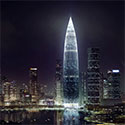
18 October 2016 | Shenzhen
Tuesday October 18, 2016. Shenzhen, China. Chongguang Xu of Shenzhen Municipal Government, presents at the 2016 China Conference Session 7b: Shenzhen Bay Development. This presentation...
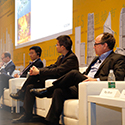
17 October 2016 | Shenzhen
Monday, October 17, 2016. Shenzhen, China. A panel discussing the challenges of growing urban populations throughout the globe.

11 June 2013 | Shenzhen
Sir Terry Farrell & Stephan Krummeck of Farrells are interviewed by Jeff Herzer during the 2013 CTBUH London Conference at The Brewery, London. Terry and...

11 June 2013 | Shenzhen
An increase in high-rise living in traditionally commerce-focused urban centers has been a key urban trend in cities across the entire globe. This has great...

11 June 2013 | Shenzhen
Tall buildings will be part of our environment in an increasing number of cities, whose ages span centuries. If it is to be integral to...

31 January 2019
CTBUH Research
In 2018, 143 buildings of 200 meters’ height or greater were completed. This is a slight decrease from 2017’s record-breaking total of 147, and it...
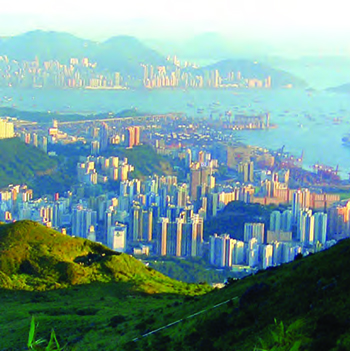
17 October 2016
Stefan Krummeck & Ben MacLeod, Farrells
Hong Kong is unique as a linear city. More than 7 million people reside, mainly in high-rise buildings, in a series of highly dense coastal...

01 September 2015
Ye Haowen, China State Construction Engineering Corporation
Experience on the construction of several 100-plus-story skyscrapers including Guangzhou West Tower, Guangzhou East Tower, and Shenzhen’s KK100 is described considering the increasingly strong development...
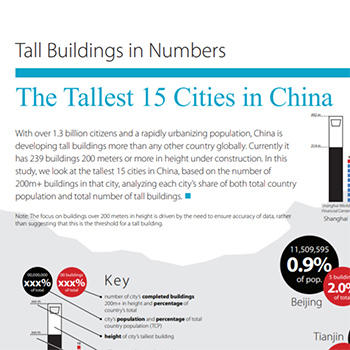
23 September 2012
CTBUH Research
With over 1.3 billion citizens and a rapidly urbanizing population, China is developing tall buildings more than any other country globally. Currently it has 239...

19 September 2012
Stefan Krummeck, TFP Farrells Limited
Recently, Asia has witnessed an astonishing proliferation of high-rise buildings. Towers are growing in numbers and in height which presents enormous opportunities and great challenges....
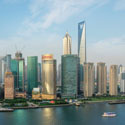
12 September 2012
Kevin Brass, CTBUH
Reports out of China these days are a jumble of mixed messages and conflicting imagery. One night network business news programs spotlight video of empty...

31 December 2011
Nathaniel Hollister & Antony Wood, CTBUH
The annual story is becoming a familiar one: 2007, 2008, 2009, 2010, and now 2011 have each sequentially broke the record for the most 200...
13 October 2016
The Council is pleased to announce the Top Company Rankings for numerous disciplines as derived from the list of projects appearing in 100 of the World’s Tallest Buildings.
21 September 2014
In Shenzhen attendees toured the sky lobby of Ping An Finance Center. Attendees enjoyed a traditional Chinese lunch at the Four Seasons Hotel before continuing to KK100.
23 September 2012
Delegates from the Congress flew to Hong Kong to visit one of the tallest cities in the world. The second day included a side trip to Shenzhen, including a private tour of KK100.
Subscribe below to receive periodic updates from CTBUH on the latest Tall Building and Urban news and CTBUH initiatives, including our monthly newsletter. Fields with a red asterisk (*) next to them are required.
View our privacy policy